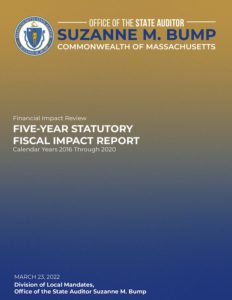Who is a member?
Our members are the local governments of Massachusetts and their elected and appointed leadership.
 A report from the State Auditor’s Division of Local Mandates identifies 29 state laws passed between 2016 and 2020 that have a significant financial impact on Massachusetts cities and towns without sufficient state funding to offset the costs.
A report from the State Auditor’s Division of Local Mandates identifies 29 state laws passed between 2016 and 2020 that have a significant financial impact on Massachusetts cities and towns without sufficient state funding to offset the costs.
The “Five-Year Statutory Fiscal Impact Report,” released yesterday, finds that the state continues to pass laws that often require resources from cities and towns for implementation, and that these measures are largely financed by local property taxes as state aid lags behind increasing local costs. The report also documents that state aid as a share of total municipal revenue decreased between fiscal 2010 and fiscal 2020, while state assessments on cities and towns increased.
The report is called for by state law (M.G.L. Ch. 11, Sect. 6B) and covers calendar years 2016 through 2020.
“This report offers a thorough and detailed account as to how pieces of legislation and statutes impact the bottom line of municipal finances,” State Auditor Suzanne Bump said of the report. “It details how, despite legislation having good intentions, there can be unforeseen cost elements associated, which can come in a variety of ways from adding staffing requirements, to adjusting formulas to determine costs, and requiring new services.
“It is our hope,” she continued, “that this report is a useful tool to members of the Legislature to take into consideration how state laws impact the limited resources of our cities and towns.”
The Division of Local Mandates reviewed 1,629 pieces of enacted legislation and identified 29 statutes with a financial impact on cities and towns, dividing them into the categories of education, elections, employees, employment benefits, licensing, municipal services, public safety, and taxation.
The 29 statutes include:
• An Act Modernizing Municipal Finance and Government (Chapter 218 of the Acts of 2016), which includes a section that provides a new formula for value of state-owned land that has a negative impact on certain municipalities
• An Act Relative to Educational Opportunity for Students (Chapter 132 of the Acts of 2019), which includes a section that rewrites definitions for the Chapter 70 program, as well as rules for calculating foundation budgets — changes that could cause higher spending by some districts that do not receive additional aid from the adjusted formula
• An Act to Improve Public Records (Chapter 121 of the Acts of 2016), which requires municipalities to designate and post the contact information of at least one employee as a records access officer, required to coordinate, document and respond to public records requests, while limiting opportunities to charge for public record requests
• An Act Relative to Criminal Justice Reform (Chapter 69 of the Acts of 2018), which requires local law-enforcement agencies to improve accountability for in-service training required by the Municipal Police Training Committee, as well as by this law, with an enhanced curriculum that includes bias-free policing and handling complaints involving persons with mental illness or developmental disabilities, among other topics
MMA Executive Director Geoff Beckwith said, “We applaud the release of Auditor Suzanne Bump’s report, which expertly documents the fiscal pressures that municipalities face as they seek to deliver core services to community residents. Auditor Bump’s Division of Local Mandates clearly explains the financial challenges at the local level, with state aid to cities and towns not keeping pace with budget needs, state mandates that are not fully reimbursed, and a growing reliance on property taxes to fund municipal services. We fully support the auditor’s legislative and funding recommendations, which would provide real relief to our communities.”
The report finds that, in fiscal 2010, local property tax levies accounted for 55.3% of total municipal revenue, and state aid accounted for 22.2%. By fiscal 2020, however, tax levies accounted for a larger share of total municipal revenue (58.4%), while the state aid share had decreased, accounting for 19.1%. Between fiscal 2010 and fiscal 2020, municipal tax levies and local receipts increased by 50.2% and 35.3%, respectively, but state aid increased by just 22.3%.
The report points out, however, that “state aid revenues do not show the entire picture of the actual funding that municipalities receive from the Commonwealth,” as cities and towns are also charged assessments by the Commonwealth for certain services and programs.
In fiscal 2020, municipalities received $5.9 billion in state aid, but were charged $1.1 billion in assessments, so municipalities actually received $4.8 billion in net state aid, representing 16.1% of total municipal revenue.
State assessments increased by $497 million (82%) between fiscal 2010 and fiscal 2020. Considering these charges, state aid net of assessments increased by just 13.7% over the 10-year period.
The report did not examine years after fiscal 2020.
The Division of Local Mandates responds to requests from local governments to determine if a state law is an unfunded mandate on municipalities. The agency also serves as a source of information on issues harming municipal budgets, and provides recommendations to address those issues.
In addition to its five-year fiscal impact report, the Division of Local Mandates issues reports on various policies having a significant financial impact on municipalities that did not rise to the level of a mandate that requires state support. In recent years, the DLM has explored and made recommendations related to public infrastructure in western Massachusetts, water infrastructure, regional schools, educational services for children in foster care, municipal police training and accountability, and payments in lieu of taxes (PILOT).
• Download the Division of Local Mandates’ Five-Year Statutory Fiscal Impact Report